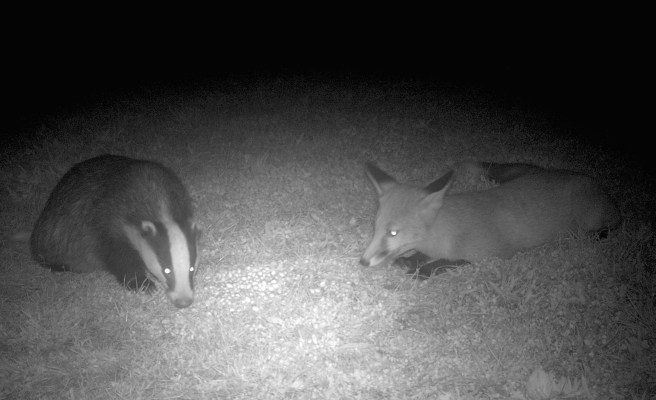
Over the past two or three years of closely observing the family of badgers that have made these meadows their home, I have come to have a deep respect and affection for them. They go trundling about their business, keeping to themselves, eating mostly earthworms and not causing any trouble. Yet badgers have been mercilessly persecuted for hundreds of years. These days they are more controversial than ever before and I can only hope that sense will eventually prevail and they will be allowed to return to quietly getting on with their lives in peace.
I pulled some reeds out of the pond a few days ago and stacked them on the side. As predicted, the badgers have already started taking them underground as bedding. It really doesn’t look particularly comfortable but that doesn’t seem to worry them:

I am still enjoying seeing all four of them contentedly eating all together at peanut time:



Especially interesting to me is to observe their interactions with the foxes who inhabit the same space along the cliff. The younger badgers are usually happy to eat alongside the foxes:


But the adult badgers have the confidence to insist that they take precedence and are not usually so accommodating with the foxes. However, this is Scarface, the adult male, in a rare moment of tolerance:

In September every year, the Swallows gather to feed over the meadows before they embark on their journey across the channel and onwards to Africa. It’s a magical thing to sit and watch them and wish them Bon Voyage as they swoop and glide in the autumn sun. Although, it is definitely difficult to capture them photographically and this is the best I could do:


Although, actually, the trail camera that we call ‘perch cam’ probably did it better than me:

The dog cannot stop herself pointlessly chasing them as they swoop, involving much thrashing around in the late summer seedy growth:

In amongst the Swallows, there was a Kestrel hovering above the meadows. It reduced its height once, twice and then plummeted down onto the ground, only to fly off empty-taloned shortly afterwards.

While on the subject of birds of prey, the Sparrowhawk was once again on the gate yesterday in her normal lurking spot:

We have seen this large hoverfly hanging around:

This is the Great Pied Hoverfly (Volucella pellucens). This is another large hoverfly that is parasitic on Wasp’s nests. Last week we saw a different Volucella hoverfly, Volucella inanis, checking out the wasps’ nest that is being rebuilt after a badger raid:

Both these hoverflies species can fly unhindered into a wasps’ nest to lay their eggs, although the nest is generally extremely well guarded. Is it because they chemically mask themselves in some way and so are invisible to the guards, or do the guards let them in because they want hoverfly larvae in the nest? Perhaps the Hoverfly larvae only eat the dead wasps, larvae and other discarded material, thus keeping the nest clean? I don’t know the answer to this at the moment but will try to find out what’s going on because I find it fascinating.
The wasps’ nest is now largely rebuilt after the badger raid. The new sphere is built under the hay on the right of the wreckage of the previous nest.

I am thinking that it might be worth getting a camera on the nest to see if it is attacked again. There has to be quite a high chance that this will happen, it’s very undefended.
A distinctive plant in the grass is the patch of Marjoram:

This Marjoram is a complete magnet to butterflies, bees, hoverflies and others over the summer and as such is a wonderful British native plant to have around. I have grown some from seeds and have now planted it out into the meadows.


Hopefully we will have a second large patch of Marjoram next summer covered in pollinators.
I am finishing with a plant today. Earlier in the year, we discovered some Black Bryony scrambling amongst the hedgerows. A climber and our only native species of the Yam family. Now that autumn is here, it has these luscious looking red berries hanging like grapes. Beautiful red berries like this are usually to tempt animals to eat them thus dispersing the seed. However, these berries are highly toxic and so therefore I do not understand the point of them and why it bothers producing them. Should I discover the reason, I will let you know.


Great article Judy 🙂 I was also interested from last time that the wasps didn’t attack the hoverfly that was pretty brazenly watching them. Google says that V. pellucens and V. ianis both feed on the living larvae of the wasps so they’re definitely parasitic. But the V. pellucens larvae are also detritivores and fall to the bottom of the nest where they eat dropped food, comb and dead wasps. It doesn’t seem to be known how they hide from the wasps – even though they’re mimics they don’t look that similar to me! Some other hoverflies have flight patterns that are very similar to their mimicked species?
Sorry for the long comment!
Thanks for the extra info, Ellie. Isn’t it so interesting? You don’t have anyone at your work who has an interest in this sort of stuff, do you?
I’ll ask the entomologists!
The entomologists agree with you and think it’s pheromone based.